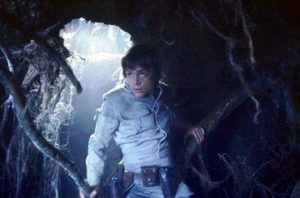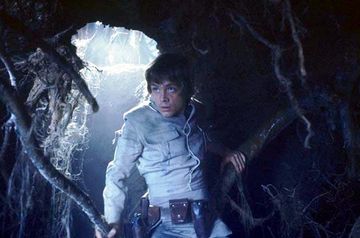Have You Visited Your “Inmost Cave” Lately?
 I love exploring. Whenever I can, I like to take my family out on hikes to explore nature. I love discovering new trails, navigating the winding terrain, listening to the wildlife… and finding caves!
I love exploring. Whenever I can, I like to take my family out on hikes to explore nature. I love discovering new trails, navigating the winding terrain, listening to the wildlife… and finding caves!Perhaps that explains why, as a writer, I love watching for the point at which a story’s “hero” approaches his “inmost cave.”
“What in the blazes does spelunking have to do with storytelling?”, you might well ask.
“Nothing… and EVERYTHING.”
I suppose I should back up and provide some context.
Back in college, Chris and I had the opportunity to take a course on screenwriting. It was in that class that we were first introduced to the work of Joseph Campbell, an American mythologist. His book entitled “The Hero of a Thousand Faces” was first printed 1949. In it, he sought to expose what he believed was a single, common story being retold throughout every culture’s unique collection of myths and literature. He referred to this concept as the “monomyth” (literally, “one story”.) Screenwriter Christopher Vogler used Campbell’s writing as a guide map for his own exploration into the story structure of modern movies. His book “The Hero’s Journey” took Campbell’s themes and distilled it into twelve story beats that every great story should hit.
One of those twelve story beats is (yep, you guessed it) “Approach the Inmost Cave”.
“What is an ‘inmost cave’,” you ask?
Well, switch on your headlamp, lace up your boots, and join me as we mine the invaluable depths of this mysterious and powerful story element.
Treasure in Them Thar’ Hills
Just like my unquenchable desire to temporarily join a bat colony, everyone is after a “treasure” of some sort. We’re all explorers on quests for some yet to be attained artifact. And that’s especially true for story characters.
Frodo labors to preserve his peaceful way of life in the Shire by destroying evil itself.
Luke Skywalker longs to take down the villain who killed his father, Darth Vader.
Thor seeks to restore himself to his rightful place as heir to his father’s throne in Aasgard.
Each of these heroes carries a deeply held desire for something more than what they have. They each have a hole that they need to fill. And they each believe that if they can just attain that one item, achievement, or status, that all will be made whole again.
That’s exactly what a brash rookie race car named Lightning McQueen (Pixar’s Cars) believes. His pursuit is for the fame (and wealth, and adoring fans) he can secure if he can just win the coveted Piston Cup. To top if off, if he can do it in his rookie year, he’ll be the fastest car to ever reach that echelon. When he closes his eyes, he can already see his posh new accommodations overlooking a city with a gleaming, spotlit trophy case to house his hopeful, record-making achievement.
But what each of these characters doesn’t know is that they really need to…
See it in a New Light
This is what the “Approach the Inmost Cave” was designed for – to provide an appropriate setting for our character to encounter their greatest desire(or fear) in a new light.
Imagine yourself standing at the gaping mouth of a deep, dark cave. Which of us would honestly run willy-nilly into its shadowy unknown? You would? Oh… alright, then. You go ahead. I think I’ll take the more cautious, thoughtful approach. I imagine I’d step carefully, mindful of every noise, with hands raised to protect myself from unexpected dangers or obstacles. I’d be quiet, on high alert. The suspense in this moment would be high. You get the picture.
In fact, it’s striking how often a story’s setting will become “cave-like” for this critical moment. Consider these “dark”, “initimate” settings:
In Star Wars (Empire Strikes Back), Luke senses something out in the jungles of Degobah. Senses heightened, he searches until he finds (duh, duh, Dum!) a cave under the roots of a massive tree. (Okay, that one was obvious). Someone emerges from the cave’s shadows and suddenly Luke is exchanging lightsaber blows with his hated enemy, Darth Vader. All of his training has been focused on this moment – the chance to kill his father’s murderer and get revenge (his greatest desire!). Luke’s lightsaber knocks Vader back, then cleanly lops off his enemy’s helmeted head. As it rolls across the ground Luke watches with surprise as the mask breaks open to reveal… his own face! The idea of killing Vader is no longer a simple one. He’s been unsettled by this vision and given a new awareness: somehow he and Vader are tied together as more than just enemies. In the end, Luke’s true battle will be to defeat his own hatred, thereby defeating the power of he Dark Side over him.
In Thor, the hero must muscle past S.H.I.E.L.D’s security forces to reach the inner court of their quarantine to recover his lost hammer (see the “cave” setting here?) Confident, he takes hold of the hammer (his greatest desire), but is shocked to discover that he cannot lift it. The hammer does not recognize him as being worthy of his father’s throne. Facing the harsh reality of this judgment, he is truly humbled for the first time.
Lightning McQueen finds himself driving into Doc Hudson’s dimly-lit garage (oh boy… another cave) and discovers not one, not two, but three Piston Cups dumped in a cardboard box alongside greasy tools. What?! Not in a shiny trophy case? Learning Doc Hudson was the famed “Hudson Hornet” of racing legend, McQueen is even more baffled by the truth Doc reveals about this once-coveted trophy – “It’s just an empty cup.” It’s safe to say that McQueen’s world has just been shaken.
The list goes on and on, movie after movie, book after book.
In fact, perhaps the most significant “inner cave” moment ever recorded was that of the disciples. You might recall the triumphant arrival of Jesus riding into Jerusalem on the back of the donkey, people lining the streets waving palm branches. They shouted “Hosanna! Blessed is He who comes in the name of the Lord!” Prophecy was being fulfilled. The King had arrived! I have no doubt that the disciples had goosebumps as they said down to celebrate Passover together that evening. They knew that something big was about to happen. They had seen Jesus’ power; witnessed his mastery over the natural world and spiritual. It was evident that nothing could stand in his way. The kingdom would be restored and they were in the front row… in a small, candle-lit upper room (can you feel the intimacy? the cave-like setting?)
Through the course of that night’s fateful events, the disciples are confronted with their own greatest desires (to be the right-hand men to usher in the new kingdom with Jesus, here on earth) in light of what their leader is telling them (“I have come to suffer. Where I go you cannot follow.”) Their world – our world – was about to change. Drastically.
Climbing Back Out
In summary, if well-crafted, an “Approach to the Inmost Cave” scene will help build suspense for your story’s ultimate ordeal to come. It plants a seed of doubt, or serves as a warning that we can anticipate something bigger before the journey is completed – even if we cannot fully understand now.
The more I study of this story beat, the more I see this as being a critical “tent pole” for the story. It’s a significant turning point. It changes everything.
And I suppose that’s why I enjoy finding this beat in stories I read and watch, or as Chris and I work to craft our own. It’s a critical heart-beat that can never get too much attention.
So, what about you? Have you visited any “Inmost Caves” recently? What stories have you read or watched recently that exemplify this concept? Or perhaps even provide exception to this rule? I’d love to hear about techniques or approaches you might use as you craft this all-important scene.
(Oh, and let me know if you found any great caves with bat colonies to visit. I’m still looking…)







































In The Paladin Prophecy, a book I just read, the MC travels deep into the labyrinthine hallways of the gymnasium, and realizes he’s not safe at the school, and the people he sees in there are connected to the abduction of his parents and they’re out to kill him.
Not sure that’s a cave though.
Interesting….
I fall back on Stephen Lawhead’s Song of Albion trilogy for this one. The first book, The Paradise War, has a literal inmost cave scene where our otherworld hero must breach the most sacred heart of his adopted people’s faith–ostentsibly to discover a murder, but really to be born into a faith of his own. I think the second book, The Silver Hand, better illustrates your point. After losing his hand in a terrible betrayal, the hero must choose whether to accept his handicap or to believe it doesn’t hinder God’s purpose for his life.
In the 3-act plot structure, which tracks both physical events on the screen and emotional inner journeys, this “tentpole” comes at a specific point. (For me, unless the scriptwriter is surprising the audience, it’s a cue to check my watch and visit the restroom, because the rest of the flows out from this point.) In the film Saving Private Ryan, for instance, the emotional journey of Upham is the one that follows this path most closely. He is a reluctant soldier at best, busy doing other things, and is forced to face his supposed good intentions as the cowardice that they are. It’s not my favorite Spielberg. 🙂
Some story-tellers, like Spielberg, make this confrontation a place of shame. That a weakness, once exposed, must be seen as the worst of someone. I think it’s the difference between humiliation and humility. One steps on a person’s neck, the other raises up a worthy ideal. The point of being humble, especially in the Christian walk, is to be willing to lay facedown at the feet of Jesus and say, “You are worthy.” Hebrews tells us that He will lift us up, not circumstance, not of our own resources, not out of pity or acknowledgement. But out of His goodness, His worthiness, and His joy. That, I think, is crucial to making an “inmost cave” scene work. That the character come away changed, not shamed. Satan would gladly meet us (or our characters) in this cave, exposing our worst sins and needs, and leaving us broken in the mud. Christ would also gladly meet us (or our characters) in this cave, birthing in us a new hope and a new sense of purpose, and giving us new shoes to walk out into the world. Guilt, or conviction? The choice is up to you, fair writer. Who do you meet in your cave?
Enjoyed this.
It seems partly an accident of logistics, but police/detective shows on TV often have a “cave” moment in an interrogation room, which is also a cave-like space.